This undated photo provided by the National Park Service shows Iceberg Lake at Glacier National Park, Mt. Scientists on Wednesday, April 7, 2010 said that Glacier National Park has lost two more of its namesake moving icefields to climate change, which is shrinking the rivers of ice until they grind to a halt. (AP Photo/National Park Service)
(AP) -- Glacier National Park has lost two more of its namesake moving icefields to climate change, which is shrinking the rivers of ice until they grind to a halt, a government researcher said Wednesday.
Warmer temperatures have reduced the number of named glaciers in the northwestern Montana park to 25, said Dan Fagre said, an ecologist with the U.S. Geological Survey. He warned many of the rest of the glaciers may be gone by the end of the decade.
"It's continual," Fagre said. "When we're measuring glacier margins, by the time we go home the glacier is already smaller than what we've measured."
The meltoff shows the climate is changing, but does not show exactly what is causing temperatures to go up, Fagre said.
The park's glaciers have been slowly melting away since about 1850, when the centuries-long Little Ice Age ended. They once numbered as many as 150, and 37 of those glaciers eventually were named.
A glacier needs to be 25 acres to qualify for the title.
If it shrinks any smaller, it does not always stop moving right away. A smaller mass of ice on a steep slope would still continue to grind its way through the Rocky Mountains.
Glacier melting has accelerated in recent decades as global temperatures have increased. Over the past century, Glacier National Park's mean summer temperature has risen by about 3 degrees Fahrenheit.
©2010 The Associated Press. All rights reserved. This material may not be published, broadcast, rewritten or redistributed.


















